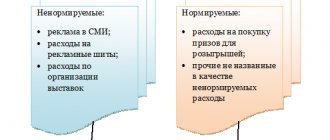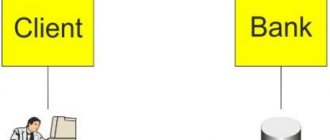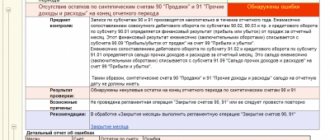What is the difference between the taxation system simplified tax system 6% and simplified tax system 15%
The “simplified” options are indicated in Art. 346.14 Tax Code of the Russian Federation. In practice, they are usually called the simplified tax system “Income” and the simplified tax system “income minus expenses”. From now on we will call them “Income” and “Income minus expenses”.
The main difference is clear from the names. With the “Income” option, the tax base is all revenue received by the businessman. Its size is determined “by payment”, i.e. upon receipt of money from customers to the account or cash register. The basic tax rate in this case is 6%.
In addition, a feature of the simplified taxation system “Income” is tax deductions, which will be discussed in more detail below in a separate section.
For the “Revenue minus expenses” option, the base is the difference between revenue and expenses. At first glance, this version of the simplified taxation system resembles the income tax used under the “regular” taxation system (OSNO). But “simplified” in this case has two significant differences from OSNO.
- Income and expenses are determined “by payment”.
- The list of expenses is “closed”. This means that if any expense is not expressly indicated in Art. 346.16 of the Tax Code of the Russian Federation, then it will not reduce the tax base.
There are no deductions when using the “Income minus expenses” object, because all “allowed” expenses already reduce the taxable base.
The tax rate in this case is 15%
Choose between 6% and 15%
A universal selection rule: if a company is engaged in the provision of services, it applies a rate of 6%, and if it trades - 15%.
Using simple mathematics, it is not difficult to understand that:
- If the organization’s costs account for more than 60% of revenue, it is more profitable to use a rate of 15%;
- If the company's costs are less than 60% of revenue, it is more profitable to apply a rate of 6%.
It is not difficult to guess that the tax authorities are interested in ensuring that the tax base is high and not underestimated. Taxpayers, on the contrary, want to achieve the smallest possible tax base.
Taking this into account, the simplified object “income” (6%) may turn out to be more profitable due to:
- Ease of determining the tax base. Since this tax is paid only on officially received income, there is no need to deduct expenses.
- Low tax risks. The tax office will pay attention only to income, since only they are the tax base. The inspection will not be interested in costs.
- Fewer documents required for confirmation (only income needs to be confirmed, there is no need to confirm expenses).
With the “income-expenses” object (15%), everything is different. It refers to a special tax regime, but it would be more correct to compare it with the general taxation system, and not with the simplified object “income”.
The advantage of the simplified “income-expenses” object compared to OSNO is the smaller turnover of documents. When using both modes, you will have to document all expenses incurred, but when using the simplified method, this requires much less documents.
How to choose a simplified tax system option based on the amount of expenses
So, a businessman has a choice - to pay 6% of all revenue or 15% of the difference between revenue and costs. To understand which simplified taxation system is more profitable, it is enough to solve a simple equation:
(H – W) x 0.15 = H x 0.06
where B is revenue, and C is costs
0.15 x H – 0.15 x W = 0.06 x H
(0.15 – 0.06) x H = 0.15 x W
0.09 x H = 0.15 x W
W = (0.09 / 0.15) x H = 0.6 x H
It turns out that if the planned expenses do not exceed 60% of the revenue, then the simplified taxation system “Income” is more profitable, and if they exceed it, then “Income minus expenses”.
Example 1
Revenue is 100 thousand rubles. Then the tax under the simplified tax system “Income” will be equal to:
H1 = 100 x 6% = 6 thousand rubles.
If costs make up 50% of revenue, then the tax under the “Income minus expenses” option will be higher:
H2 = (100 – 100 x 50%) x 15% = 50 x 15% = 7.5 thousand rubles.
If costs amount to, for example, 70% of revenue, then the tax for “Income minus expenses” will already be lower than for “Income”
H2 = (100 – 100 x 70%) x 15% = 30 x 15% = 4.5 thousand rubles.
But not everything is so simple... We also need to take into account the impact of tax deductions.
conclusions
In general, it is most profitable to pay UTII. But not all types of activities can use this mode. Between OSNO and simplified tax system, 15% choose the simplified version.
If a company's costs are 60% less than its income, it is more profitable for it to choose a rate of 15%, and if it is 60% more - 6%. In addition to the low simplified tax rate of 6%, compared to the simplified tax system of 15%, its advantage is that you do not need to keep track of expenses. This means that accounting costs become much lower. Tax risks that are associated with incorrect interpretation of costs and the need to prove the legality of each expense made are also reduced.
Based on the article, we can draw the following conclusion: you can determine what rate will be beneficial for your organization only by taking into account the specifics of your activity and assessing the profitability of the business.
To make the best choice, it is best to contact a consulting organization. Specialists with extensive experience in this matter will help you make the right choice and provide the most profitable option, clearly justifying your position.
Similar articles
- Calculation of transport tax (accounting entries)
- USN: rates
- Rules for calculating the minimum tax under the simplified tax system
- How to reduce the simplified tax system on insurance premiums?
- Can an LLC choose a simplified taxation system?
What tax deductions are provided under the simplified tax system “Income”
The final tax amount under the simplified taxation system “Income” can be reduced by a number of types of costs (Article 346.21 of the Tax Code of the Russian Federation):
- Mandatory insurance contributions from the wage fund.
- Sick leave payments.
- Payments under voluntary insurance contracts in favor of employees.
- Trade fee.
The procedure for applying the deduction depends on the category of businessman and the type of expenses themselves.
| Type of deduction | Legal entities and individual entrepreneurs (IP) with employees | Individual entrepreneur without employees |
| Mandatory and voluntary insurance contributions, as well as sick leave | up to 50% of the tax amount | no limits |
| Trade fee | no limits | no limits |
Information about the simplified tax system
The simplified form can be used by companies that meet the following conditions:
- Total income for the year does not exceed 64 million rubles;
- The average number of employees is less than one hundred people;
- The company's fixed assets cost no more than one hundred million rubles.
There are several types of activities in which you cannot use the simplified form, even if the company fully complies with the above conditions. But most activities can use the simplification without problems.
Simplified language can be used by both organizations and individual entrepreneurs. The procedure for using it is almost the same for them. The only differences are in paying the final tax amount for the year and submitting tax reports. Entrepreneurs do this on April 30, and legal entities on March 31.
When using the simplified tax system, the taxpayer has the right to independently choose the tax rate: 6% or 15%. This should be chosen carefully as it cannot be changed until the end of the tax year.
How to take into account tax deductions when choosing the simplified tax system option
The trade tax is currently relevant only for Moscow. Therefore, most “users” of the simplified tax system (except for “micro” entrepreneurs without employees) can reduce the final tax amount by no more than 50%.
In other words, the rate under the simplified tax system “Income” in this case seems to be “reduced” from 6% to 3%.
If we substitute 3% instead of 6% in the equation discussed above, then it is easy to calculate that the “threshold” cost value will be equal to 80% of revenue.
In this case, the amount of deductions is important, or more precisely, its relationship with the amount of the “simplified” tax. If through deductions it is possible to completely “cover” half of the accrued tax, then the simplified taxation system “Income” will be beneficial until costs exceed 80% of revenue. If the amount of deductions is smaller, then “intermediate” options are possible in the cost share range from 60% to 80%.
How to calculate which is better - simplified tax system 6% or 15%?
To more accurately calculate the profitability of a particular bet on the simplified tax system, you can use the equation.
By substituting expenses into the equation X = 1.25 (Y + A), you can understand whether the object of taxation has been chosen correctly. The formula will be useful to those who are thinking about changing the object of taxation to a “simplified” tax at the end of 2021.
X indicates income, exceeding which the object of the simplified tax system-15 becomes unprofitable. By A we mean insurance premiums and sick leave that are not reimbursed by social insurance. The value of Y is equal to other expenses that the “simplifier” has the right to write off.
If your real income is greater than X, it is better to work on the “income” object. That is, the inequality “income - expenses” < X < “income” is true here. When they are equal to X, the tax burden is the same.
Let's show this with an example.
Example
The income of IP Vasiliev for 2015 amounted to 600 thousand rubles, insurance premiums with sick leave (the part not reimbursed by social insurance) - 15 thousand rubles, other expenses - 350 thousand rubles.
X in this case is equal to 456.25 thousand rubles. 1.25 x (350 thousand + 15 thousand) = 456.25 thousand rubles.
The real income of an entrepreneur is greater than X, so when choosing a simplified tax system of 6% or 15%, which is better is clearly visible. It is more profitable for IP Vasiliev to work on the USN-6.
The tax burden in this case is less than under the simplified tax system-15 (see table). With income of 456.25 thousand rubles, the object of taxation does not matter, since the amount of taxes deducted is the same.
Example 2
Revenue – 100 thousand rubles, tax under the simplified tax system “Income” without taking into account deductions is 6 thousand rubles. If the amount of deductions is greater than or equal to 3 thousand rubles, then the final amount of tax payable will be half less than the original:
H1 = 6 x 50% = 3 thousand rubles.
In this case, the simplified taxation system “Income minus expenses” becomes beneficial only if the costs are more than 80% of the revenue, for example
H2 = (100 – 100 x 90%) x 15% = 10 x 15% = 1.5 thousand rubles.
If the amount of deductions is less than half of the tax, for example, 2 thousand rubles, then the tax under the simplified tax system “Income” will be equal to
N1 = 6 – 2 = 4 thousand rubles.
Then the option “Revenue minus expenses” can be profitable even with a smaller share of costs in revenue
H2 = (100 – 100 x 75%) x 15% = 25 x 15% = 3.75 thousand rubles.
The benefits of using each of the objects, taking into account the businessman’s category and the share of costs, are shown in the table
| Share of costs in revenue | up to 60% | from 60% to 80% | over 80% |
| Legal entities and individual entrepreneurs with employees who do not pay the trade fee | "Income" | Depends on the relationship between the amount of tax and the amount of deduction | "Income minus expenses" |
| Individual entrepreneurs without employees and payers of trade tax | "Income" | Depends on the relationship between the amount of tax and the amount of deduction | |
As for individual entrepreneurs without employees and payers of trade tax, the taxation system of the simplified tax system “Income” can be beneficial for them at any ratio of revenue and costs, incl. and in case of losses.
The fact is that for these categories, the “Income” object allows you to “zero” the tax through deductions (of course, if their amount is sufficient for this). And the “Income minus expenses” object in any case does not make it possible to completely free yourself from payments to the budget. Even if a loss is incurred, the businessman is obliged to pay a minimum tax of 1% of the proceeds (clause 6 of Article 346.18 of the Tax Code of the Russian Federation)
Tax rates of the simplified taxation system
Any entrepreneur wants to save on payments to the budget. Even when choosing a simplified tax system, the question arises - which of the two rates will be more profitable when doing business.
But it is impossible to immediately say which one will be more economical. For each company, you will have to calculate savings separately, since much depends on factors such as the availability of employees, income and profit.
As an example for calculations, a certain company will be used that receives an income of 1.5 million rubles. Of which, 1 million rubles are expenses for needs - 6%
This rate assumes that all funds earned by an entrepreneur during the reporting period are subject to tax. In this case, expenses are not taken into account at all. How much I earned - from that amount I paid 6%.
Tax calculation is simple. It is enough to multiply all revenue received by 6%. That is, the formula will look like this:
1,500,000 * 6% = 90,000 rubles.
An entrepreneur will be required to pay this much if he works at a rate of 6%. When working for yourself, you can safely deduct all contributions to compulsory health insurance and compulsory medical insurance .
But if the company has employees, you can further reduce the tax through the following payments:
- Contributions to extra-budgetary funds for employees.
- Sick leave for employees (except for industrial accidents and occupational diseases).
- Payments to employees under voluntary insurance if the employee is temporarily disabled under certain conditions.
All these payments can be deducted from the tax amount received when calculating the tax. But the tax cannot be reduced by more than 50%.
That is, if the employer paid 50 thousand in contributions and sick leave, only 45 thousand can be deducted from the final amount for payment.
If there are no workers at all, then the restrictions are lifted by 50%. And, if the tax turns out to be less than the fixed contributions already paid for pension and health insurance, then you will not have to pay it.
The main disadvantage of the six percent rate is the instability of income. Sometimes the expenses can be very high and the entrepreneur makes no profit at all. But the state is not interested in this, so you will still have to pay 6% (even if everything went to expenses).
“Income minus expenses” – 15%
This tax assumes that the entrepreneur will pay 15% of profits, and not of earnings in general. All expenses that the business owner is able to justify and document will be taken into account. And you won't have to pay for them.
To find out the amount of tax at a rate of 15%, it is necessary to subtract from the revenue received all expenses that the entrepreneur can document and justify. Then multiply the resulting number by 15%. It will look like this:
(1500000 - 1000000) * 15% = 75000 rubles.
Possible expenses are listed in Article 364.15 of the Tax Code of the Russian Federation. In this case, all eligible expenses from the list must be documented. If this fails, the amount spent “without documents” cannot be included in the calculation. All checks and receipts will have to be kept. Moreover, you need to keep a Journal of expenses and income, where you register each action and attach documents to it.
The main disadvantage of the 15% rate is the need to carefully monitor documents that can confirm the expenditure. This is offset by dignity - the entrepreneur pays in proportion to the success of his enterprise. If the profit is small, then you will have to pay a little.
But even if it suddenly turns out that expenses are equal to income or even exceed it, you will still have to pay. And the minimum tax should be 1% of all revenue received, regardless of the amount calculated by the formula.
How to address the risks associated with cost recognition
We must not forget that the simplified taxation system “Income minus expenses” is associated with more complex accounting and additional risks.
There is always a possibility that counterparties will not provide the necessary documents on time, or that the tax authorities will not accept certain expenses based on the results of the audit.
Therefore, if calculations show that the benefits from using both options are approximately the same, then it is better to choose the simplified taxation system “Income” in order to simplify accounting and reduce risks.






